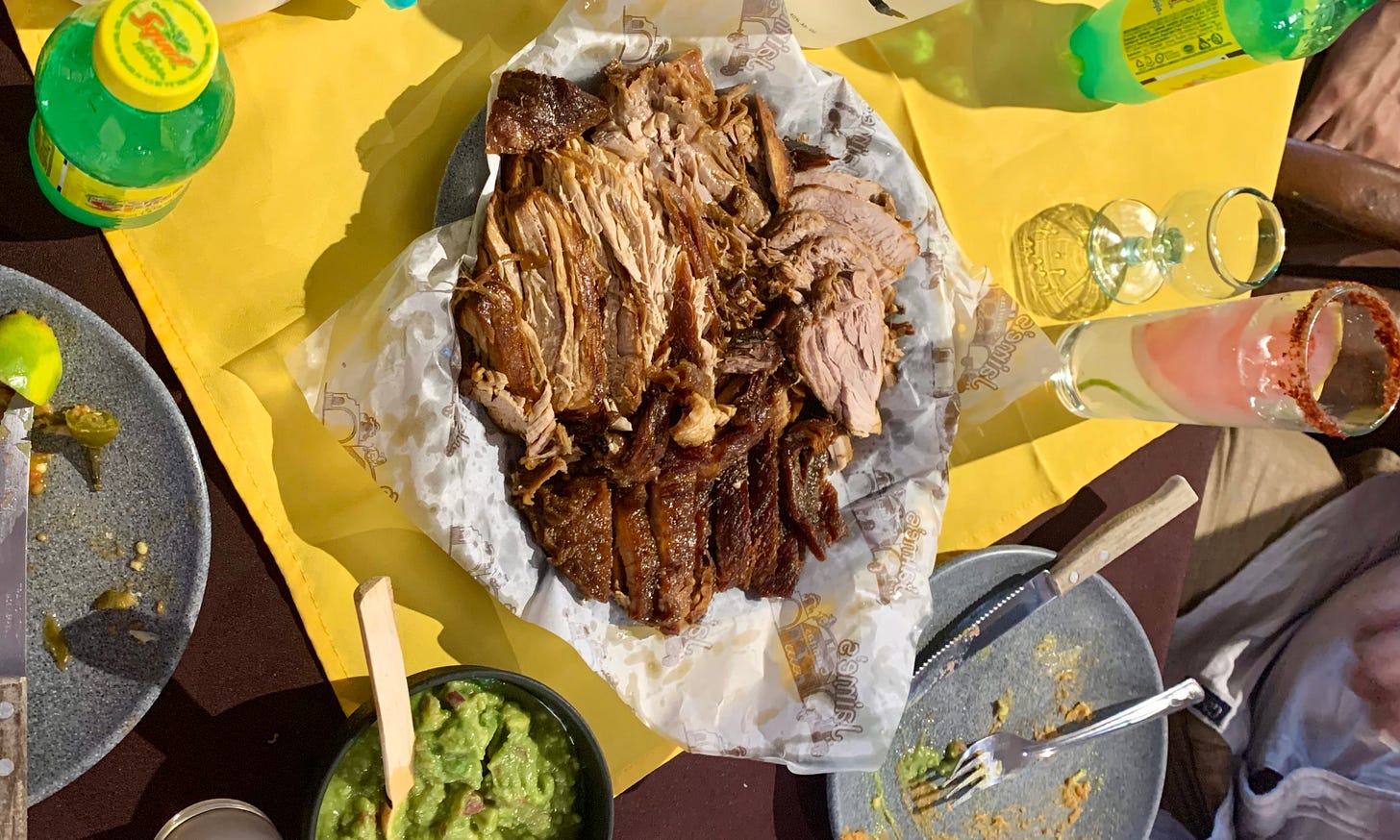Cazeula: a pot, earthenware, wide and shallow. It’s for cooking stews, casseroles, things of that nature, things that sustain you, like broths and braise-y things. Corn, potatoes, beef, rice, plantains, sausage, squash, things of that nature. Flavors meld, the clay communicates with the heat, et cetera.
In Jalisco, a cazuela is still a pot—still earthenware, still wide and shallow. It’s small, the size of a bread plate, and you need to pick it up from the bottom with both hands. The naked clay is cool and dusty as you raise it to your mouth. It’s filled with sliced grapefruit, lime, orange, a splash of Squirt®-brand soda, and tequila.
Driving from Guadalajara through the highlands to Arandas, you’ll see the dirt turn red: It’s clay soil, lots of iron, which they say is great for the agave. The altitude is also great for the agave, makes the tequila sweeter, more delicate. You can feel your ears popping. There are mountains in the distance—where did they come from? Grass, corn. And then, eventually, the surface of the earth becomes hostile, covered in spikes that can draw blood with a single swipe: miles of razor leaves, the fields of Agave tequilana packed in tight rows until they disappear over the edge.
We stop at an estate and are led around by farmers in fitted pants, boots, belt buckles, broad-brimmed hats, cutting a cowboy silhouette in the fields. Agave farmers are called jimadores, it’s a job that requires skill and fortitude on many levels; before they harvest the thing, pruning it in a matter of seconds with a long-handled shovel-knife called a coa and then wresting it from the soil with one foot and some impossible, effortless leverage, they have to look at it and know it’s ready in the first place. The woman whose family owns the place shows us how to measure the Brix level of an agave with a refractometer, which tells you if it’s sweet enough to use, but needless to say the refractometer is a formality.
It’s not too hot, but the sun is high and closer than you think. The back of my neck is turning pink, I will discover later. My shoes are turning pinky-brown from the clay. The agave here is used to make the best tequilas in the world, apparently. Later, we try some—it’s sweet and grassy, as smooth as the sound the coa makes when it slices off the agave leaves, like the snip of a barber’s shears.
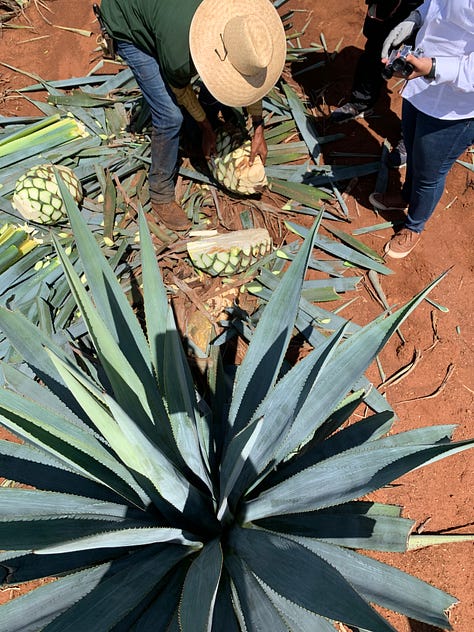

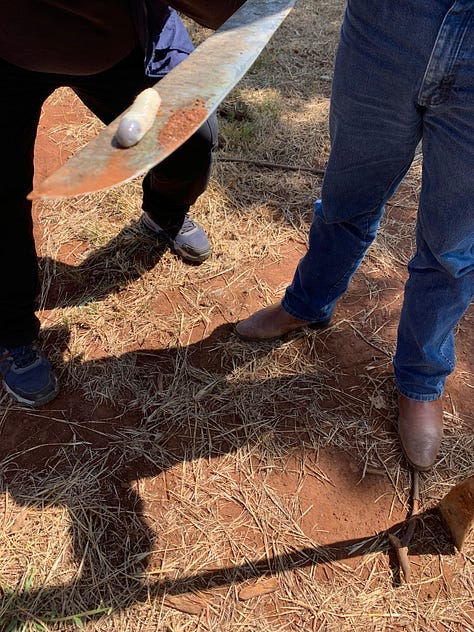
Mariachi: música ranchera, passion, lovesickness, homesickness, Mexico. Strings and brass—an opinionated, resonant sound. It feels like all mariachis can sing, somehow: big and full sound you can almost see in their throats as they throw it, vibrating, out of their bodies, but it looks like it’s the easiest thing on earth to them, something they could do laying flat on the ground or while looking at their phone. Traditional mariachi garb is also taken from the charros, the famous look of patrician Tapatío horsemen and later Zapata and his rebels, a look that’s both noble and of the people, like mariachi, I guess, and a lot of good art: tight pants and boleros embroidered with gold, big, heavy sombreros, and silky ties in bows around their necks.
In Jalisco, mariachi originated in Jalisco. We heard it through the speakers on our drive to the highlands, a playlist of covers of every possible variety: Ozzy Osbourne or Daft Punk transformed into strains of folk nostalgia—moving, really—until you recognize the song, that is, and then you can’t quite unhear it. Live mariachi, though, is energizing when it’s fast, and when it’s slow and syrupy, it’s like that sound therapy thing where they put singing bowls around you and play them until it shakes your skeleton. At Carnitas Jaime’s, the mariachi was twelve suede-voiced men taking turns sending a beautiful belted note bouncing around the dining room, resonating between the sides of your skull.
There is a small boy waiting outside the entrance to the restaurant when our van pulls up, and he has a large bag slung around his body. He has freckles and hair the color of an old coin, or the color of the big copper pots where the carnitas roil in bubbling oil out back. I greet him and wave, and he looks me in the eye and says nothing. Later, he hangs around as the mariachis encircle our table, leaning against his father’s leg, his head fitting snugly under the curve of the big guitar as they play La Malagueña.
The restaurant is full and somehow familiar, with wooden ceilings and terra cotta floors. From the rafters, elaborate tissue-paper flags in every color and tin lamps shaped like stars. Yellow walls, yellow tablecloths, fresh-hot tortillas wrapped in yellow napkins in a basket. The barrel of every leather chair filled with someone eating, and everyone, everyone, eating carnitas: carnitas filling the room.
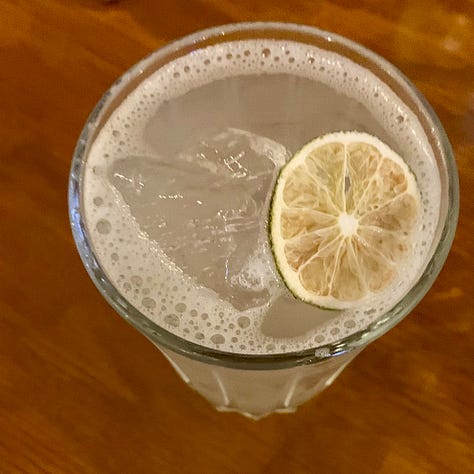
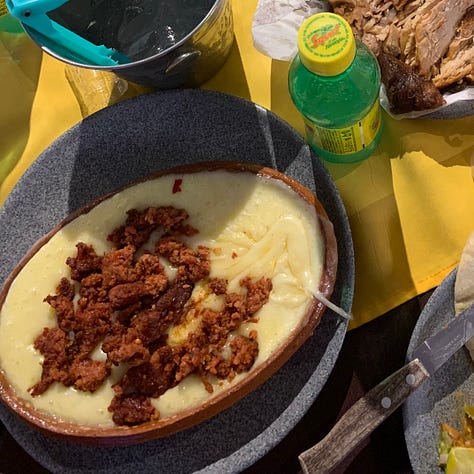
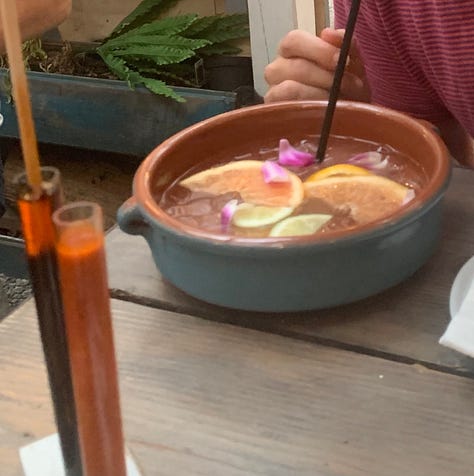
Carnitas: pork, all parts, rendered and pulled, crackly. In Jalisco, carnitas originated in Jalisco, where the best pigs are. You’ll need a cauldron to do it right, rendering the lard and cooking the meat in a warm bath for hours, confit-like, then turning the heat way up for a final deep-fry to shock the skin and fraying edges into crispiness.
At Carnitas Jaime’s, carnitas are a life’s work, an inheritance. Jaime started making the carnitas 40 years ago (thank you, Jaime) and they still come fanned out on a plate, cut by cut, so heavy you can’t pass it with one hand—porky skin as thick and translucent as a dark toffee. A mountain of quartered limes, a whole pickled jalapeño smashed into a fresh tortilla. At Carnitas Jaime’s, carnitas are a folded bite, fatty and soft, as you drink your tequila and Squirt® through a straw and listen to a singer who could make you cry if he wanted, but he doesn’t.
would order again: carnitas, queso fundido con chorizo, guacamole, tortillas hechas a mano, muchas cazeulas
carnitasjaimes.com • @carnitasjaimes
note: this meal was not comped by the restaurant, but it was free; a tequila brand organized lunch here for a group of press after a tour of their agave fields.




